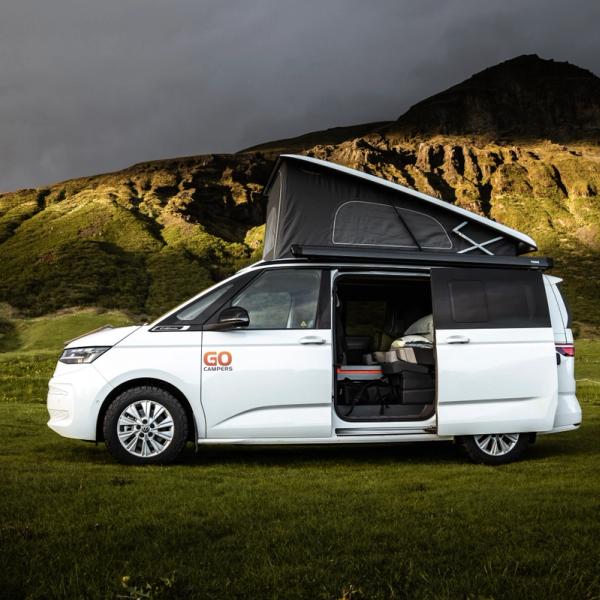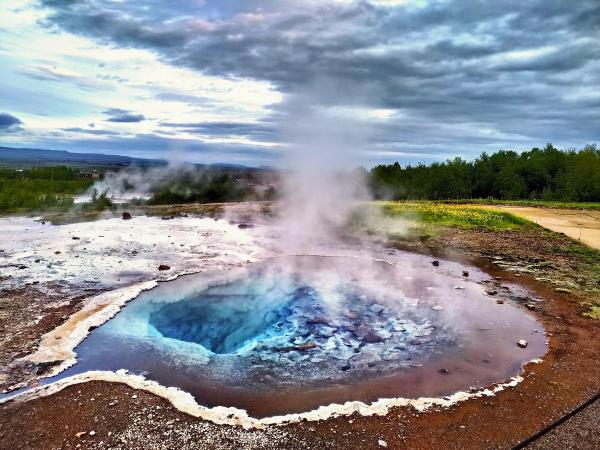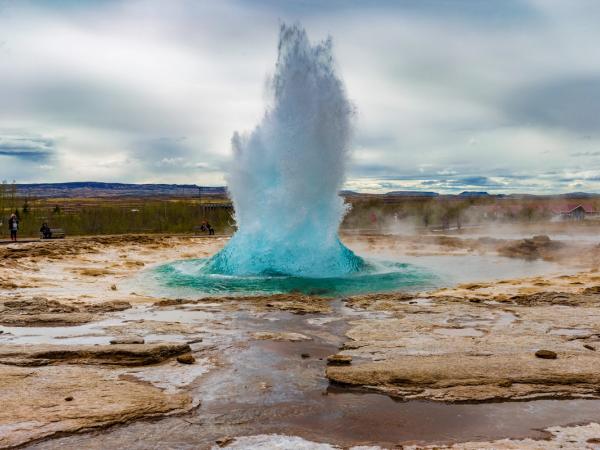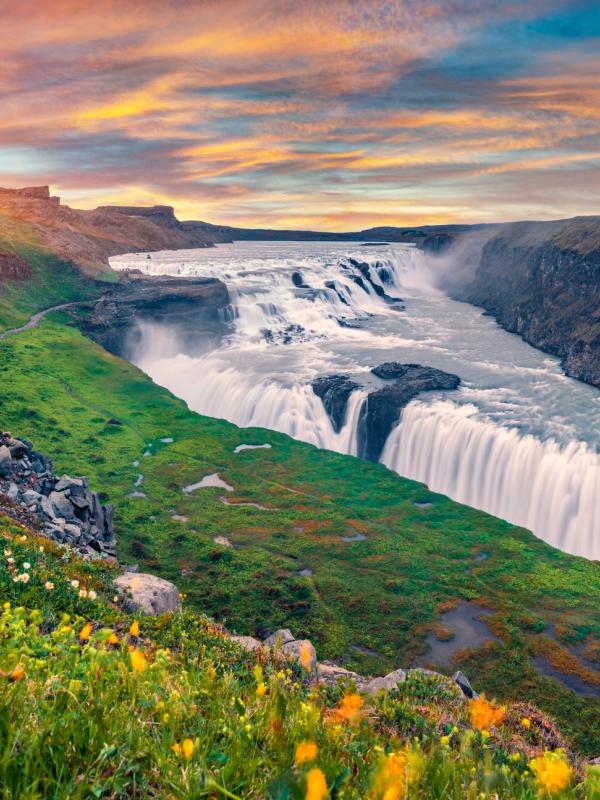
Gullfoss Waterfall: Iceland's Crown Jewel of the Golden Circle
Iceland's Gullfoss is the country's most famous waterfall. This two-tier cascade drops 32 meters into a big canyon, creating one of nature's best photo spots. But here's the thing - it's also Iceland's busiest natural attraction, so you'll need some tips to make the most of your visit.
Key Takeaways
- Gullfoss is a 32-meter waterfall with two drops (11m and 21m) along Iceland's Golden Circle route
- Located 1.5-2.5 hours from Reykjavik with free parking, it's easy to reach but often crowded
- Best viewed from upper platform year-round; lower platform may close in winter
- Geysir Campground and Skjól Camping are the closest and best camping options nearby
What's Gullfoss?
Gullfoss means "Golden Falls" in Icelandic. It gets its name from the golden shimmer you'll see when sunlight hits the glacial water. The Hvítá river, fed by Iceland's second-biggest glacier, Langjökull, creates this mighty cascade that flows at about 140 cubic meters per second in summer and 80 in winter.
The waterfall has two steps - the first drops 11 meters, then a bigger 21-meter plunge. The water then disappears into a narrow canyon that runs sideways to the river's flow, creating a unique L-shaped waterfall.
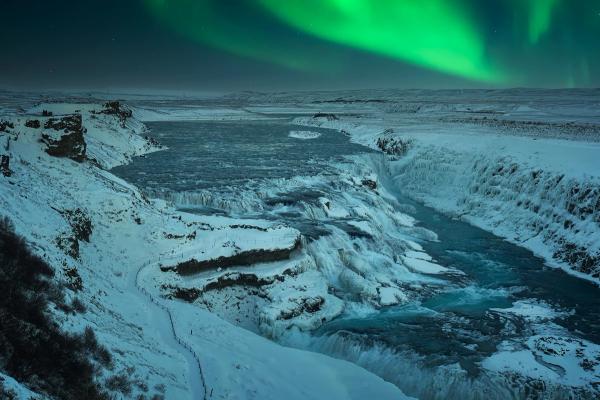
Why is Gullfoss Worth Visiting?
Even though it's Iceland's busiest natural attraction, Gullfoss lives up to its hype. The sheer power of the water hitting the rocks creates a misty show that's visible from far away. During sunny days, you'll often see rainbows in the spray, and in winter, when it's partly frozen, Gullfoss looks like an ice sculpture.
What makes it special isn't just the waterfall itself - it's the whole Golden Circle experience. Visiting Gullfoss puts you perfectly placed to see Iceland's most famous geysers and Thingvellir National Park on the same day. Plus, it's one of the few major Icelandic waterfalls where you can drive right up and walk to viewing areas without challenging hikes.

How Gullfoss Was Formed
Gullfoss exists because of Iceland's wild geological history. During the last Ice Age, massive glacial floods carved out the canyon you see today. These weren't regular floods - they were massive releases of meltwater that shaped Iceland's landscape.
The Hvítá river carries glacial meltwater from Langjökull glacier, which gives the water its brownish color and adds to the "golden" effect. Over thousands of years, this powerful flow has carved a 2.5-kilometer-long canyon that's 20 meters wide, creating the perfect conditions for this waterfall.

Fascinating Facts About Gullfoss
Here's something most visitors don't know: Gullfoss almost didn't exist as we see it today. In the early 1900s, there were plans to build a hydroelectric plant that would have destroyed the waterfall. Enter Sigríður Tómasdóttir, whose family owned the land. She threatened to throw herself into the waterfall if the project went ahead, and her passionate fight helped save Gullfoss. You'll find a stone memorial with her profile near the waterfall - it's worth pausing to appreciate this piece of conservation history.
Gullfoss has also made its mark in pop culture. It appeared on the cover of Echo and the Bunnymen's album "Heaven Up Here," in Live's music video for "Heaven," and even in episodes of "Avatar: The Last Airbender" and "The Amazing Race."
The flow of the waterfall changes a lot with the seasons. In summer, when glacier melt peaks, you'll see about 140 cubic meters of water thundering over the edge every second. In winter, this drops to 80 cubic meters, and parts of the waterfall can freeze into incredible ice formations.
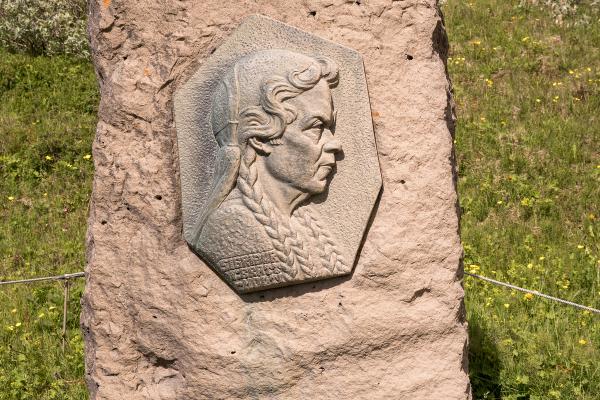
How to Get to Gullfoss
Getting to Gullfoss is easy. The best way is by renting a campervan (or a car), as it gives you total freedom to stop anywhere and stay for as long as you want at each place.
From Reykjavik, it's about 1.5 to 2 hours by car, depending on your route and stops. The coordinates are 64°19′34″N 20°07′16″W if you're using GPS.
There's free parking right at the site, next to the visitor center. From the parking lot, you'll walk about 10 minutes via staircases or 20 minutes via ramps if you have strollers or need wheelchair access.
The roads are well-maintained, but in winter, they can be icy. If you're not comfortable driving in winter conditions, consider joining a guided Golden Circle tour from Reykjavik instead - many companies offer day trips that include Gullfoss, Geysir, and Thingvellir.
What to Do at Gullfoss
Admiring Gullfoss is enough to make it a worthwhile visit, but you can do more than just watch.
Upper Viewing Platform
This is your main viewing spot, open year-round no matter the weather. From here, you get expansive views of both waterfall tiers and the land around them. It's wheelchair accessible via ramps and offers excellent photo opportunities without any risk of getting soaked by the spray.
The platform has safety barriers and is about a 10-15 minute walk from the parking area. Even on busy days, there's usually enough space for everyone to get their shots. This is where most visitors spend their time, especially in winter when the lower platform is closed.
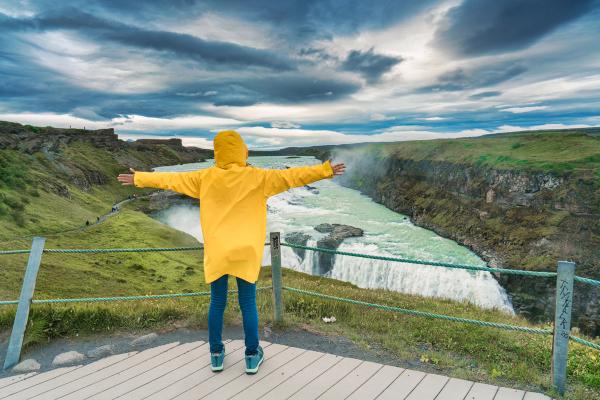
Lower Viewing Platform
For a more exciting experience, the lower platform gets you close enough to feel the power of the falls. You'll be right at the edge of the canyon, with mist spraying up from below - definitely bring a waterproof jacket or rain poncho.
This platform is typically closed from November through April due to ice and safety concerns. Even in summer, the path can be slippery, so wear good shoes. The walk down takes about 5-10 minutes, but it's steeper than the upper route.
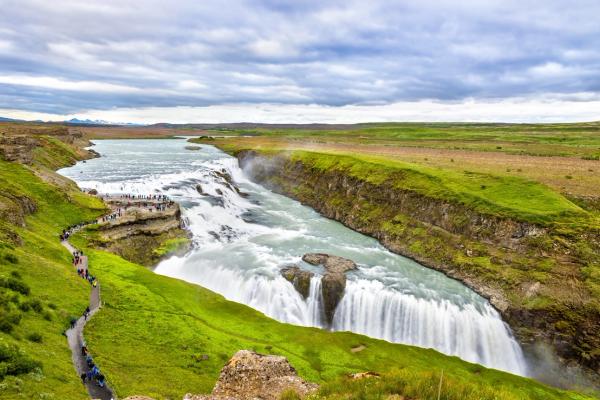
Visitor Center and Facilities
The modern visitor center is worth more than a quick look. Inside, you'll find:
- Free, clean restrooms (the outdoor ones by the parking lot charge 200 ISK)
- A restaurant and café serving traditional Icelandic food
- Gift shop with local souvenirs and warm clothing if you've forgotten weather gear
- Info displays about the waterfall's formation and conservation history
Staff can tell you about current trail conditions and weather updates, which is especially helpful for planning activities like the lower platform visit.
Photography Tips
Set aside at least 30-45 minutes for photography. The changing mist creates different lighting throughout your visit. Early morning (7-9 AM) and late afternoon (4-6 PM) typically offer the best light and fewest crowds.
Bring a lens cloth - the mist gets everywhere. For the best shots of the full waterfall, use the upper platform. For dramatic close-ups with spray and rainbows, brave the lower platform when it's open.
Adventures from Gullfoss
Gullfoss is the starting point (or part) of different trails and tours that give you a more immersive experience.
Glacier Tours and Snowmobiling
Langjökull glacier snowmobile tours leave right from the Gullfoss parking area, making them an easy add-on to your waterfall visit. These trips typically take 2-3 hours, and include all equipment (snowmobile, helmet, warm gear), and transport to the glacier.
No experience is required - guides provide complete training before you hit the snow. Tours run year-round but are especially popular in summer when the glacier access is easier. Prices start around 100$ per person.

Hiking Tungudalur Valley
The valley trails offer a different view of Gullfoss and the canyon system. The main route is about 4 kilometers round-trip with minimal elevation gain, taking 1-2 hours depending on your pace and how many times you stop to take photos.
Start at the marked trailhead near the visitor center. The path follows the canyon rim and provides excellent photo opportunities away from the crowds. Pack water and snacks, as there are no facilities along the trail.
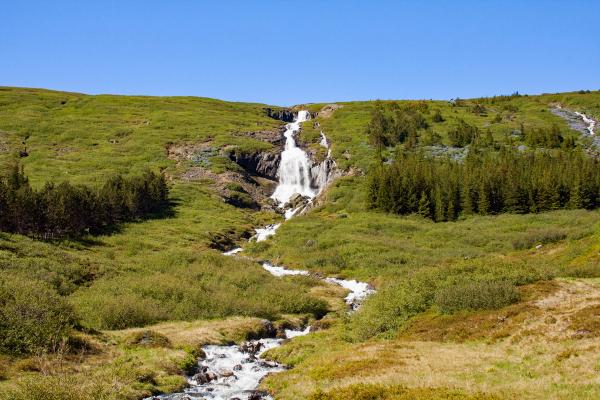
Horseback Riding
Icelandic horses are known for their unique "tölt" gait, making them surprisingly comfortable even for beginners. Tours around Gullfoss typically last 2-3 hours and explore the rugged landscapes and lava fields nearby.
Most tours provide helmets and basic instruction. Some offer pickup from Reykjavik or major hotels, while others meet directly at Gullfoss. Prices vary, but expect to pay around $150-$170 for a basic tour. Dress in layers - it's always cooler on horseback.
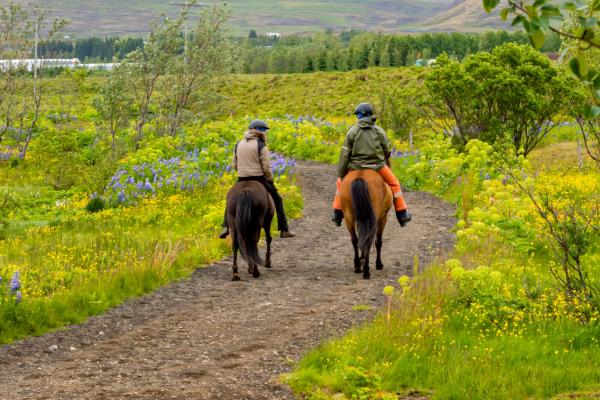
Ice Cave and Into the Glacier Tours
During winter, special tours take you inside Langjökull glacier through man-made tunnels. These 3-4 hour trips include snowmobile transport across the glacier and guided exploration of ice caves.
Tours require booking in advance and leave from the Gullfoss parking area. All equipment provided, including crampons and headlamps. Temperatures inside the glacier hover around 0°C year-round, so don’t forget to bring warm clothing.

Photography Workshops
Several companies offer specialized photography tours focusing on Gullfoss and the other Golden Circle attractions. These typically start before sunrise and continue through the golden hour, teaching composition and technical skills specific to Iceland's landscapes.
Led by professional photographers who know the area, these tours often access lesser-known viewpoints and provide insights on capturing Iceland's dramatic weather and lighting conditions.
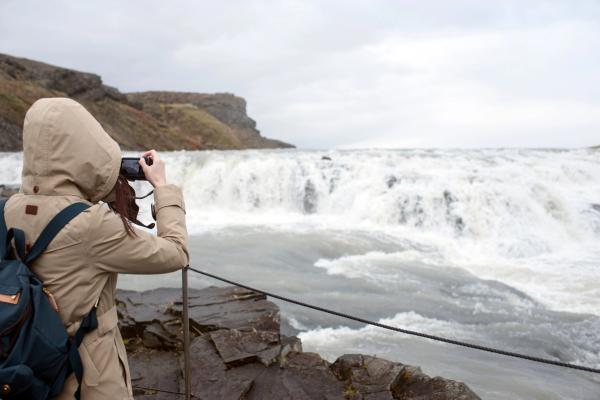
Best Places to Camp Near Gullfoss
If you want to experience the area beyond a day trip, camping puts you right in the heart of Golden Circle country. Two campsites are particularly convenient and pleasant to stay at:
Geysir Campground
This campsite sits just 10 minutes from Gullfoss by car. It's part of the Geysir geothermal area, so you can easily visit both attractions in the same evening or early morning. The campground accommodates both tents and campervans with basic facilities, and it costs $17.

Skjól Camping
This one offers more amenities if you want extra comfort. It’s located near both Gullfoss and Geysir, and it features spacious tent grounds and cabins for rent. Facilities include well-maintained shower blocks, a kitchen area, Wi-Fi, and a restaurant/bar where you can meet other travelers.
Both campsites are best booked in advance, especially during peak season (June-August). Camping here lets you visit popular sites early in the morning or late in the evening when tour groups are gone.
What Else to See in the Area
Gullfoss is strategically located near some of the most incredible attractions in the country, so a visit to Gullfoss is never a one-stop visit.
Geysir Geothermal Area
Just 10 minutes from Gullfoss, Geysir is home to Iceland's most famous geyser, Strokkur, which erupts every 5-10 minutes, shooting water 15-20 meters into the air. The whole geothermal area spans about 3 square kilometers and includes hot springs, mud pots, and the namesake Great Geysir (though it's mostly dormant now).
You can easily visit both Gullfoss and Geysir in the same morning, completing two-thirds of the Golden Circle before lunch. The walkable boardwalk takes about 30-45 minutes to explore fully, and there's a visitor center with shops and food options.
Thingvellir National Park
About 45 minutes from Gullfoss, Thingvellir is one of the three national parks in Iceland. It’s where Iceland's parliament, the Althing, was established over 1,000 years ago. Beyond the historical significance, it's one of only two places on Earth where you can see the Mid-Atlantic Ridge above sea level - meaning you're literally standing between two continents.
The main sights include the Almannagjá gorge, Öxarárfoss waterfall, and the beautiful Silfra fissure (a popular spot for diving and snorkeling). Park entry is free, though parking costs about 1,000 ISK. Plan at least 2 hours to see the main highlights.
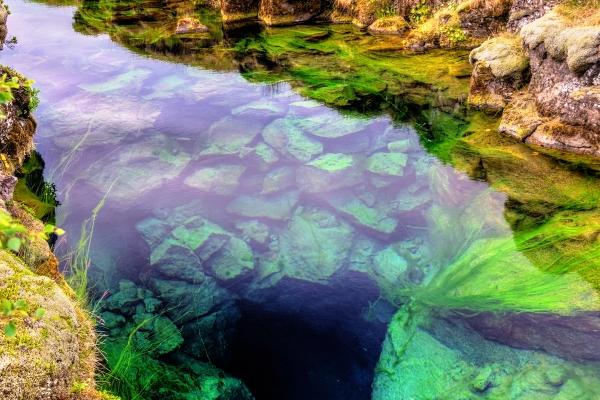
Faxi Waterfall
A lesser-known gem just 40 minutes from Gullfoss, Faxi (also called Vatnsleysufoss) is a wide, relatively low waterfall that most tourists skip. This makes it perfect for peaceful photos and a quick stop between Golden Circle sites.
The waterfall spans about 80 meters and drops only 7 meters, but its horseshoe shape creates a beautiful cascade. There's minimal infrastructure here - just a small parking area and a basic path to the viewing area.
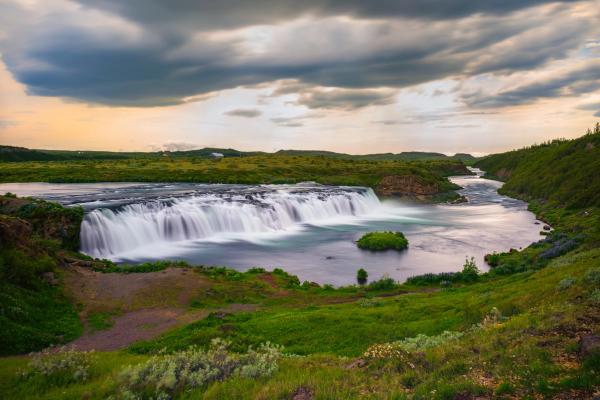
Kerid Crater
This 3,000-year-old volcanic crater lake is located 30 minutes from Gullfoss. The red volcanic rock and turquoise water create a striking color contrast that's particularly photogenic. You can walk around the rim (takes about 10-15 minutes) and descend to the water's edge.
Entry costs 400 ISK, and it's included in many Golden Circle tours. The crater is especially beautiful in the late afternoon when the sun illuminates both the water and the colorful mineral deposits in the rock.
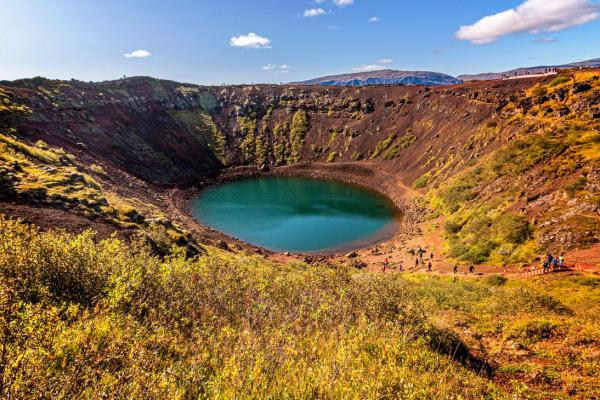
Day Trip Planning Tips
Most visitors combine all three Golden Circle sites (Gullfoss, Geysir, and Thingvellir) in one day, which is doable but rushed. Here are some alternatives:
- For a relaxed pace, split the Golden Circle over two days, camping at Geysir Campground or Skjól Camping
- If doing it in one day, start early (before 9 AM) to beat the tour buses
- Consider adding just one extra stop (like Kerid or Faxi) rather than trying to see everything
- In winter, factor in shorter daylight hours and potentially icy roads
Conclusion
Gullfoss delivers on its reputation as Iceland's top waterfall. Yes, it gets crowded - it's the country's most visited natural attraction for a reason - but with some planning, you can still have an amazing experience. Visit early or late to avoid peak tour bus times, bring waterproof gear for the spray, and take time to explore beyond just the main viewpoints.
Whether you're driving yourself or joining a tour, camping nearby, or day-tripping from Reykjavik, Gullfoss offers that quintessential Icelandic nature experience that's easy to reach yet still awe-inspiring. Just remember that this golden wonder is best appreciated with a bit of patience and the right timing.

